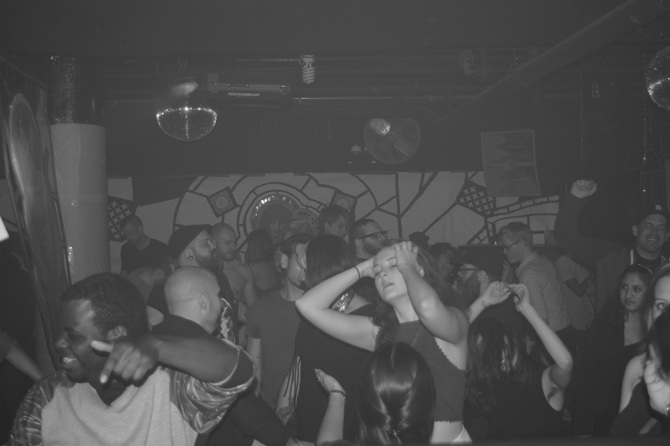Generators was a six-part immersive exploration of the subjective history of the queer nightclub. Across six podcast style narrative audio chapters and six corresponding IRL parties, a range of artists across mediums revealed their personal experiences with queer nightlife and the stakes of their investment. These audio stories were posted online ahead of the actual events, so club goers could make connections from the online to real life versions of the project.
︎ USA
︎ USA
Generators
A Nightclub Project
role: creator, overall project lead
︎2015
A Nightclub Project
role: creator, overall project lead
︎2015





︎︎︎project mini website ︎︎︎
Podcast Episode Writers
Marke Bieshke
Leo Herrera
Ariel Zetina
Podcast Episode Voice Actors
Kevin Clarke
Ms. Boogie
Karis
Podcast Soundtracking
Jacob Sperber
Robert Yang
Jason Kendig
Visual Installations
Tom Slazinski
Podcast Episode Writers
Marke Bieshke
Leo Herrera
Ariel Zetina
Podcast Episode Voice Actors
Kevin Clarke
Ms. Boogie
Karis
Podcast Soundtracking
Jacob Sperber
Robert Yang
Jason Kendig
Visual Installations
Tom Slazinski
Generators seeks to share the history of the queer nightclub, passing on stories that have traditionally resisted official codification. We are in a historical moment that has yet to grant many queer people their full humanity. Thus the nightclub retains its valence as site of political resistance, where our differences are celebrated and our lives affirmed.
In 2015, the Honey Soundsystem crew was awarded a coveted residency at the Smart Bar nightclub in Chicago by then booker Marea Stamper (aka The Blessed Madonna). In the grand tradition of ‘artist residencies’ I came up with a way to enhance our bi-monthly takeover of the longest running nightclub in America.
Working with Marea and the Smart Bar team we pulled in Red Bull Music Academy and fleshed out a budget to pull off the ambitious project.
Each week before the bi-monthly club night, an episode from the six-part story was released online (in the form of streaming audio poetry). Chicago-based visual artist Tom Slazinski decorated the club, sometimes in elaborate installation pieces that corresponded to the narrative of that month's audio episode.
Generators enlisted three generations of queer club-goers from the ‘80s, ‘90s, and ‘00s who took turns telling their stories, while Honey Soundsystem members provided the soundtrack.
The Generators project served as a symposium for many brilliant minds. We hand-picked artists from various mediums–writers/poets, performers, visual artists, activists, and musicians–in our queer nightlife community orbit.
Alongside creating work for Generators, artists were asked to delve into their sketchbooks and diaries to share in a larger conversation behind the curtain. To inform a community we must inform each other, and although everyone involved was already well versed in queer history and identity, we shared personal stories and inspirational documents to create a greater unified understanding. The varying backgrounds and ages of the artists helped bridge the gap between each person’s knowledge and lived experience thus far and what they could learn from each other. Threads of similarity were found across cultural and racial lines and even some hidden truths came out.
As the lead on this project I coordinated our brand partnership oversaw our budget; managed all aspects of the podcast, including recording, editing, and public release; and initiated the ideation process with talent.
Working with Marea and the Smart Bar team we pulled in Red Bull Music Academy and fleshed out a budget to pull off the ambitious project.
Each week before the bi-monthly club night, an episode from the six-part story was released online (in the form of streaming audio poetry). Chicago-based visual artist Tom Slazinski decorated the club, sometimes in elaborate installation pieces that corresponded to the narrative of that month's audio episode.
Generators enlisted three generations of queer club-goers from the ‘80s, ‘90s, and ‘00s who took turns telling their stories, while Honey Soundsystem members provided the soundtrack.
The Generators project served as a symposium for many brilliant minds. We hand-picked artists from various mediums–writers/poets, performers, visual artists, activists, and musicians–in our queer nightlife community orbit.
Alongside creating work for Generators, artists were asked to delve into their sketchbooks and diaries to share in a larger conversation behind the curtain. To inform a community we must inform each other, and although everyone involved was already well versed in queer history and identity, we shared personal stories and inspirational documents to create a greater unified understanding. The varying backgrounds and ages of the artists helped bridge the gap between each person’s knowledge and lived experience thus far and what they could learn from each other. Threads of similarity were found across cultural and racial lines and even some hidden truths came out.
As the lead on this project I coordinated our brand partnership oversaw our budget; managed all aspects of the podcast, including recording, editing, and public release; and initiated the ideation process with talent.




On the final night of the Generators residency, several of the artists involved were flown to Chicago to speak. Before the club lights turned on and young dancers filled the dancefloor, fans of the project were able to hear the audio episodes on Smart Bar’s Funktion One sound. Afterwards a moderated artist talk took place under Tom Slazinki’s final art installation.
For the final night, Tom created a massive, silver mylar chandelier-esque centerpiece suspended at eye level in the middle of the dancefloor. The dreamlike metallic cloud held portraits of hundreds of victims to trangender hate crimes. The sprit of our sisters, brothers, and others were brought back to the center of the ‘gay bar.’ It reiturated a main theme from the project, that often one of the only spaces queer people can be free and safe is in the nightclub and on the dancefloor itself.